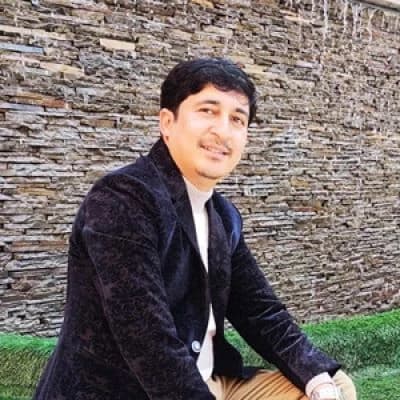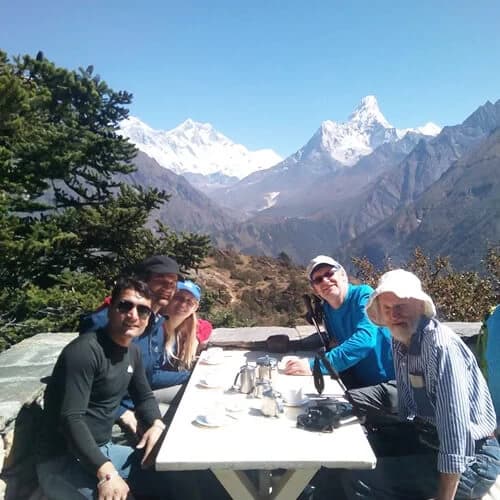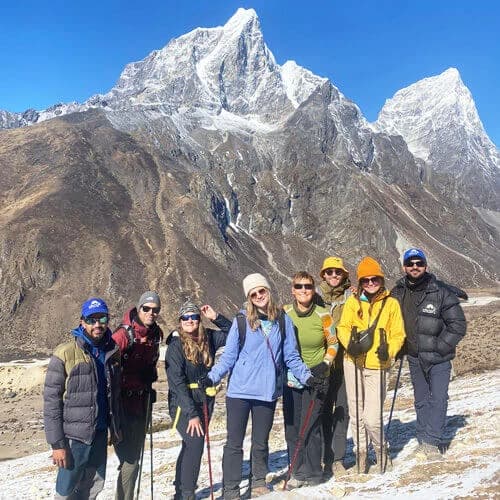Everest is one of the most popular trekking regions in the world, featuring the infamous Everest Base Camp Trekking that takes you to the foothills of the world’s tallest mountain, Mt. Everest. The region, located in the mid-eastern Himalayas, is easily connected to the capital city by airways. The Khumbu region is blessed with unmatched natural beauty complemented by the cultural richness of Sherpas, known for their contribution to mountaineering. Strolling in the wilderness of Sagarmatha National Park, witnessing dense vegetation with unique flora and fauna, and hiking in the barren lands of the alpine landscape with a backdrop of the world’s highest mountains is a dream family trip.
Everest Base Camp Trekking for Children and Senior Citizens
Here’re a few treks you can do with your kids and elderly family members in the Everest region.
Everest Base Camp Luxury Trekking
Maximum Altitude - 5545 m
Trip Length - 16 days
Trek Difficulty - moderate
Trekking in the Himalayas doesn’t always have to be an absolute adventure compromising comfort and luxury. Since the beginning of trekking in Nepal, the Everest region has advanced itself to provide its visitors with luxurious stays and outstanding food options. The Everest Base Camp Luxury Trekking is a perfect trek to bask in the splendor of the Himalayan conquest. You can now finish the EBC journey in style, that is, in luxury. For instance, you and your family can sleep in comfortable beds while eating multi-cuisine food, accompanied by drinks and desserts, and hire as many horses and porters as you require, which can also motivate your children.
Everest View Trekking
Maximum Altitude - 3900 m
Trip Length - 7 days
Trek Difficulty - easy
As its name implies, the Everest View Trekking is an easy trek that leads to a breathtaking view of Mount Everest and the surrounding mountains. This short trek offers a wide range of panoramic mountain views in the Khumbu region as well as unique opportunities for cultural exchange with the Sherpa people and their rich, interconnected Buddhist tradition. This trek is recommended for anyone, including kids and seniors, looking for a simple journey that enables them to appreciate the magnificence of the Nepalese Himalayas, particularly Everest, without having to do lengthy, difficult trekking.
Everest Base Camp Helicopter Trekking
Maximum Altitude - 5545 m
Trip Length - 7 days
Trek Difficulty - moderate
Did you know you can trek to the EBC on foot and return back on a helicopter? Yes! That’s right. The Everest Base Camp Helicopter Trekking allows you to hike all the way up to the Everest Base Camp and Kala Patthar on foot, taking in the exceptional Himalayan vistas of the Khumbu region. What makes this trek suitable for children and seniors is that you take a helicopter flight on your way back from Gorekshep to Kathmandu directly. You don’t have to take a knee-jolting hike down, which is a relief for your elderly family members, and your kids will love the chopper ride.
Difficulties While Trekking with Kids and Elderlies
All the family treks mentioned above are categorized as easy or moderate treks and are attainable by kids and elderlies. However, we cannot deny the difficulties that may arise during the hike. So, it's important to be aware of the safety issues and be prepared to tackle them. We've listed some of them below. Let's have a look.
Altitude Sickness
Altitude sickness, also known as Acute Mountain Sickness (AMS), is a serious issue in high-altitude trekking due to the decreasing oxygen level in the thin air of the Himalayas. AMS can occur in anyone, irrespective of age or physical fitness. However, trekking with children and seniors becomes tricky as you have to take care of yourself and your family members in case you get sick. So, when trekking with family members of vulnerable age groups, try to avoid places above 4000 meters and take extra time for acclimatization.
Trek Length
Lengthy treks that go on for weeks at a high altitude can be exhausting even to fit adults. Imagine how hard it would be for children and older people to trek in the rugged terrain of the Himalayas for a long time. It's obviously taxing. So, make sure to choose treks that do not involve continuous hiking for days. A week-long trek is appropriate for kids and elders. If you're going beyond that, take frequent rest days so that your body can recover.
Remoteness
Remotely located treks are hard to get to. It takes either a risky mountain flight or a long off-road bus/jeep ride to reach the trailhead, which can be a challenge for kids and seniors. The remoteness also means you won't have access to medical care or basic everyday supplies. So, you have to pack extra to get all the necessary items for your kids and elders, adding weight to your shoulders.
Illnesses
AMS is not the only health risk while trekking in the Himalayas. You or your family may encounter injuries or gastrointestinal illnesses caused due to unclean food and water. As adults can communicate their symptoms clearly, treating them is easy. But in the case of a child, it's hard to detect the problem, and it may lead to complications. But with a little extra care on the trail, drinking purified water and eating local healthy food after washing your hands with soap and water can solve half the problems.
Advice for Everest Trekking in Nepal with Kids and the Elderly
"Prevention is better than cure." Instead of regretting later, try and avoid the problems beforehand so that you and your family can enjoy a trouble-free trekking journey. Here's some expert advice to help you save your family trek from failing miserably.
Choose the right trek
When looking for treks to do with your family, make sure that each family member is comfortable doing the trek. Determine their strengths beforehand and choose the altitude and length of the trek wisely. A standard altitude for kids and elders would be 4000 meters or less, and the trek length (time you spend on the trail) would be a week or less.
Pick an appropriate itinerary
Now that you've picked your trek, it's important to follow an itinerary that is suitable for your family. Make sure the daily hiking duration is at most 5-6 hours, and take frequent rest days for acclimatization in case of a high altitude or a lengthy trek.
Buy the right gear
An adult can compromise with the trekking gear. Some may not need trekking poles or trek with regular shoes instead of hiking shoes. But for kids and elderlies, adding a pair of trekking boots, hiking poles, or rain gear may provide them with significant convenience. Ensure everyone has broken into their shoes before beginning the trek to avoid blisters.
Carry extra supplies
We always suggest packing the things that are absolutely necessary while trekking. But it's a different story while trekking with kids. It's essential to carry supplies that will keep your children entertained, like playing cards, travel games, pen and paper, books, etc. Mind you, there's no TV available in the teahouses. Likewise, treating your kids with their favorite snack at the end of the hike motivates them to keep going.
Hire potters
You may be able to carry your own backpack, but the kids and seniors won't. So, hire potters to share your load. Let your kids walk freely and enjoy the trek. Hiring a potter in Nepal isn't expensive at all. It won't add a lot to the total cost. Also, if you're trekking with small kids, be open to the possibility of having to carry the kids at some point. So, hiring potters is the best decision.
Consider everyone's physical fitness
Trekking in the Himalayas for several days isn't a piece of cake. It takes a fit body with enough stamina. Before even planning the trek, consider if you and your kids and elders are fit enough to participate in the taxing adventure of trekking. Take your family for running, swimming, and day hikes to get them ready.
Don't overlook the mental/psychological aspect
An adventure like high-altitude trekking takes so much more than a fit body. It's you stepping out of your comfort zone. So, one needs to be mentally healthy and psychologically ready to adapt to an entirely new environment each passing day for a certain duration in the challenging weather of the high Himalayas.
Here you go! We've presented a well-researched list of the best family-friendly trekking destinations in Nepal to trek with children and seniors, along with possible difficulties and advice to overcome them. As we conclude the blog, we hope to have helped you choose an appropriate trek for your upcoming family vacation in Nepal. If you've further questions or if you'd like to book any trek, don't hesitate to reach out to us. Feel free to communicate your needs, as we also offer customized excursions for private bookings. Reconnect with your family in the Himalayas of Nepal!
Some Most Popular Treks
- Everest Base Camp Trek - 14 Days
- 12 Days Everest Base Camp Trek
- Everest Base Camp Luxury - 14 Days
- Everest Cho La Pass - 17 Days
- Everest High Pass 16 - Days
- Annapurna Base Camp - 13 Days
- Ghorepani Poon Hill - 7 Days
- Annapurna Circuit - 17 Days
- 12 Days Annapurna Circuit Trek
- Manaslu Circuit - 14 Days
- Manaslu Trek 12 Days
- Everest Base Camp with Island Peak - 16 Days
- Everest Luxury Trek with Helicopter Return
- Langtang Valley - 10 Days




